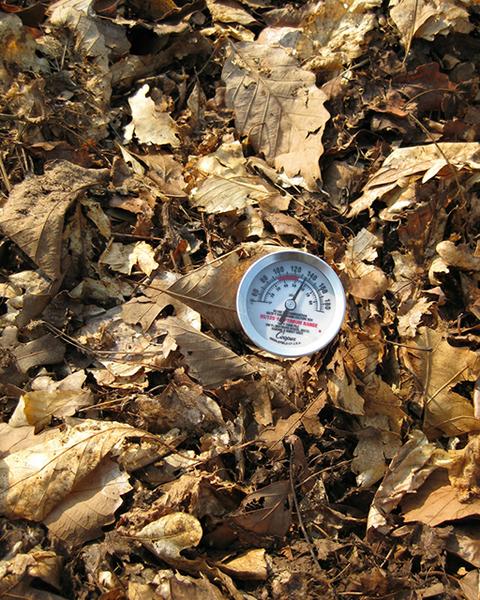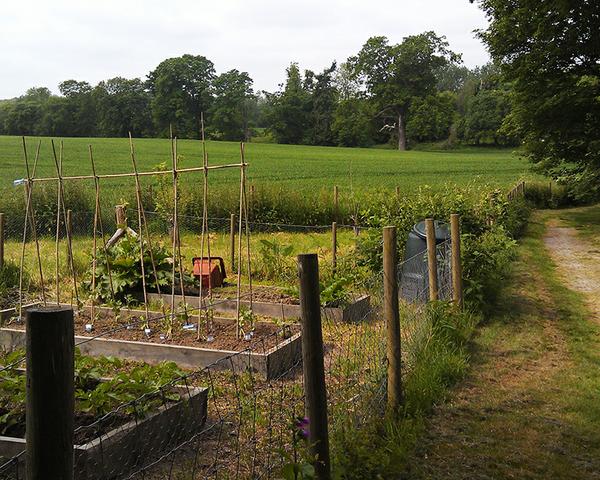To maximize the health and nutritional benefits of fresh-grown produce, gardeners must attend to food safety while growing, harvesting, processing, and storing their vegetables. These easy, common-sense ideas can make any community garden's harvest safer and more healthful.
The Centers for Disease Control and Prevention estimate that each year 48 million people in the United States suffer from food-borne illnesses, many of which were contracted by eating fresh fruits and vegetables contaminated by bacteria and viruses. Because most food safety problems are not easily washed off, prevention is critical.
|
Prevention strategies to make community garden harvests safer:
Based on Chaifetz et al. (2012). |
Site Selection
Protecting food safety begins with site selection. Obtain a history of the site and conduct a soil test to evaluate the safety of gardening on the site (Crozier et al. 2012). Consider prior land use, proximity to sources of polluted run-off, potential for flooding (that could wash in pollutants), chemicals and heavy metals in the soil, and prior use of animal manure. Garden sites near current or former highways may have high soil lead levels due to decades of exhaust from cars using leaded gasoline.
Soil safety tests
If a review of the history suggests soil contamination could be a problem, have the soil tested for contaminants, including heavy metals such as lead. These can cause health complications to those working in the garden or eating the harvest, and are very difficult to eliminate from the soil.
Soil safety tests are distinct from conventional soil tests for plant nutrients, which provide recommendations for fertilizer and lime applications. Safety tests may need to be specially ordered and may entail additional costs. If the soil is contaminated, consider finding an alternate site.
Check to see if soil safety tests already exist for a given site. This is likely to be true for designated brownfield or cleanup sites, which are sometimes offered as locations for urban agriculture or community garden projects.
If a site has contaminated soil, raised beds lined with plastic to prevent vegetable contact with the contaminated soil may be the only practical short-term solution. In some cases, however, it may be that the land should not be used for food growing of any kind for the foreseeable future, and that a community project other than a garden might be better suited for the site.
Agricultural Chemicals
Pesticides are subject to a three-step rating system indicating increasing toxicity: caution, warning, and danger. Always follow pesticide and fertilizer label directions to the letter, wear appropriate personal protective equipment when working with chemical products, and store materials carefully. This applies to both conventional and organic products.
Some gardens have a locked shed or box for pesticides; others do not allow them to be stored in the garden at all. These safeguards help prevent unintentional contamination and reduce danger to children. Gardeners may be surprised to learn that organic products and homemade garden sprays can also pose food safety and environmental risks. To ensure safety, handle all garden products with care.
Hand Washing
The US Centers for Disease Control and Prevention estimates that over half of foodborne illnesses are linked to poor hand washing. Washing hands with soap and water is the best way to reduce the number of potentially harmful microorganisms. Search on-line for a variety of attractive, functional, easy to build hand washing stations.
If washing with soap and water is not possible, use a hand sanitizer with 60% alcohol or wear disposable single-use gloves while harvesting and when cleaning produce.
Water
For all water used for irrigation, hand washing, or cleaning produce, use a regulated, treated water source, or have the water tested to ensure that it meets EPA drinking water standards.
Avoid rivers, streams, irrigation ditches, wells, or ponds that could be sources of contamination, including pathogens and toxins.
If your garden harvests rainwater from buildings, have the water tested to be sure it meets EPA drinking water standards and is not being contaminated by bird droppings or other pathogens. Monitor for other contamination, such as lead-rich chips of old weathered paint. Retest harvested water periodically. Also, store the water in a way that does not allow mosquitos to breed.
Irrigation
Apply water to the soil, not the plant. Minimize splashing, which may carry diseases from the soil onto the leaves and stems, infecting the plants and contaminating the harvest.
Both mulch and drip irrigation help prevent soil splash and also conserve water. When hand watering, apply carefully and slowly to minimize splash. Overhead sprinklers are not recommended for food gardens because they make it impossible to control soil splash. “Pop up” style lawn sprinklers should not be used in food gardens.
|
WHAT'S THE PROBLEM? Water, manures, soil contamination, even compost may carry deadly threats into community gardens. Pathogens
Toxins
|
Compost
Composting turns green waste into a valuable asset that improves the health of the soil and plants, leading to more bountiful harvests. Manage compost with food safety in mind. In community gardens, compost usually comes from one of two sources: purchased compost from outside the garden and compost made largely from materials within the garden, often mixed with leaves and sometimes kitchen scraps.
When purchasing, select products certified by the US Composting Council or ask to see test results documenting the contents and establishing the absence of contaminants. Testing may require a fee and some planning, but dealing with contamination once compost is incorporated into the soil becomes much more costly and time-consuming.
For garden-made compost, be sure to use best practices. Locate the compost bin downhill and as far from the garden as possible to keep unfinished compost out of the garden. Exercise reasonable caution and common sense when acquiring organic matter for the compost pile to minimize the risk of bringing in contaminants. Most of the material composted will be plant material from within the garden, such as overripe produce and young weeds that have not gone to seed.
A “hot” composting process that involves turning the piles and sometimes adding supplemental nitrogen to help the pile heat to temperatures greater than 130°F for at least five days will kill most pathogens. Always wash your hands after working with compost and before harvesting or working in the garden. Seek help from Extension and other knowledgeable sources when designing your composting system. If you exercise caution, include only healthy plant materials, and keep rodents out of your pile, you should be able to minimize risk. When in doubt, test garden-made compost before use.
NC State discourages using manures or fertilizers made with sewage sludge or bio-solids in compost to be used on food gardens.
Animal feces can deposit pathogenic E. coli, Campylobacter, Shigella, Salmonella, and other illness-causing microorganisms. Fence out rabbits, raccoons, groundhogs, dogs, deer, bears, and other animals. Pets can also become a problem, even if they are carefully monitored. Do not allow dogs or other pets in the garden.
Tall fencing or an electric fence may help keep deer out of the garden, and smaller mesh wire can sometimes help exclude rodents. In addition, keep the compost bin covered to deter scavenging animals.
The most effective strategy to prevent issues with animals, however, is to keep the garden clean and free of rodent-harboring weeds, trash, or mulch piles and to harvest on a regular basis. Nothing attracts animal pests more than overly ripe or rotting produce. Some gardens institute a “you harvest when ripe, or we will harvest it for you and donate it” policy during heavy harvest periods, where the garden is regularly gleaned on a given day each week, and ripe crops are given to charity.
Using poison bait to control mammal pests is not recommended in community gardens because the risks are too great.
Sanitation and Tools
Food harvesting, processing, and storage methods also play important roles in food safety. Wash tools using 1 tablespoon of bleach per gallon of water. Wash hands before harvesting and put harvested food into clean, sanitized containers. Do not wash produce until it is to be consumed (Chaifetz et al. 2012). Larger community gardens that donate or sell their produce may want to consider adding a simple washing and processing area similar to ones used by small farmers.
Publication date: Aug. 10, 2017
AG-806
Other Publications in Collard Greens and Common Ground: A North Carolina Community Food Gardening Handbook
N.C. Cooperative Extension prohibits discrimination and harassment regardless of age, color, disability, family and marital status, gender identity, national origin, political beliefs, race, religion, sex (including pregnancy), sexual orientation and veteran status.



